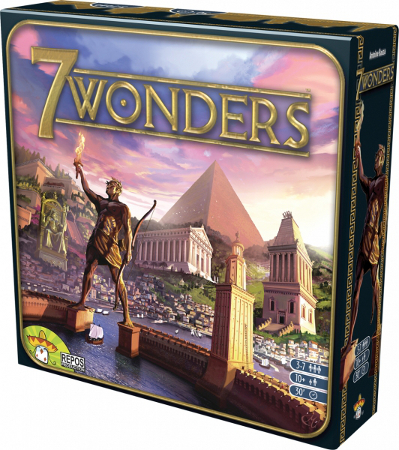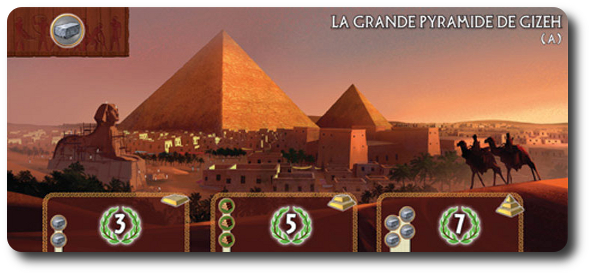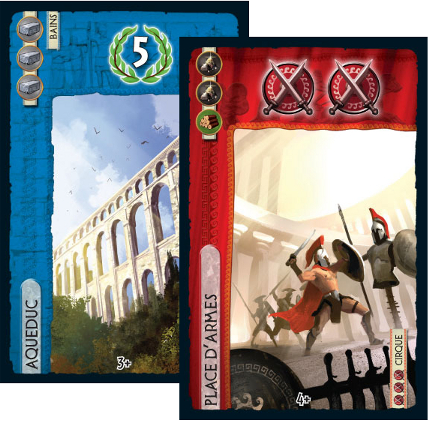
The Basics:
- For ages 10 and up
- For 3 to 7 players
- About 30 minutes to complete
Geek Skills:
- Hand/Resource Management
- Strategy & Tactics
- Logical & Critical Decision Making
- Counting & Math
Learning Curve:
- Child – Moderate
- Adult – Easy
Theme & Narrative:
- Build your own ancient civilization in as little time as 30 minutes!
Endorsements:
- Gamer Geek approved!
- Parent Geek approved!
- Child Geek approved!
Overview
7 Wonders is a game where players try to lead an ancient civilization from its earliest beginnings to become a world power. Players can develop their civilization as military powerhouse, establish a merchant state, or master science and technology. Over a series of three Ages, players will first develop a collection of resources that are used in later Ages to build structures, train a military, research technologies, and even build a world wonder. The player who has the most developed civilization (i.e. victory points) after the third Age wins the game.
Components
- 7 Wonder boards
- 7 Wonder cards
- 49 Age I ”Foundation” cards
- 49 Age II ”Growth” cards
- 49 Age III ”Apogee” cards
- 42 Flag tokens
- 20 Gold coins
- 40 Silver coins
- 1 score pad
Component Break Down
Wonder Boards
These are heavy cardboard boards that are used to depict a player’s civilization. Each civilization starts with a base resource indicated in the upper left of the board and each civilization gets a special bonus for building the stages of their wonder (noted on the bottom of the board). These bonuses can be additional victory points at the end of the game, boosts to military might, bonus technologies, ways to build free structures, and other perks.

Example of one of the many civilization Wonder boards a player can select from or be randomly given
Ages I/II/III Cards
These cards are collected throughout the game in order to build up a civilization. The first Age consists mainly of raw resources such as ore, wood, glass, linen, and other building materials. These resources can then be used to build structures, research technologies, or develop the military over the course of the game. The second Age has a few more resources plus more structures. By the third Age, the only focus of the civilization is using previous resources from the first and second Age to build additional and very costly structures, technologies, and guilds that provide the player large amounts of victory points. In addition, each Age has military cards that can be played and used to attack players on the left and right of the player using them. The military might of the player’s civilization is calculated at the end of the game to give additional victory points.

Example of some of the Age cards
Game Set Up
At the beginning of the game, each player is given a random Wonder board that represents one of 7 ancient civilizations such as Giza, Rhodes, and Alexandria. Then, three decks of cards representing Ages 1 through 3 are setup and shuffled. The number of cards in each deck is dependent on the number of players. The cards are clearly marked showing which cards will be used making it easy to organize the game. Any cards removed during the game set up are out for the duration of the game.
Each player then gets 3 Silver coins and all the Age I cards are dealt to the players. Once all the cards are dealt, each player will have 7 cards.
Now the game can begin.
Playing the Game
At the beginning of the first Age, each player looks at their hand of 7 cards, keeps one, plays it in front of them, and then passes the remaining cards in their hand to the player on their left. When a player plays a card, they must pay for the associated cost. This cost, as represented by resource icons, is in the upper left hand corner of the card. Any resources a player has on their civilization Wonder board can be used for free. If a player to the left or right has a resource the player needs, they can pay that player 2 Silver to use that resource. Note that the player doesn’t physically take the resource card from the player they purchase it from, but they do have access to it as if it was in front of them. Thematically speaking, consider it like a trade route between neighboring civilizations.
Players continue to play cards and pass their hands to the left until only two cards remain. The player then selects one of the two cards and discards the other. At the end of the first Age, the only point tallying that is done is based on military. The red military cards have military icons on them. A player compares the number of military icons to the number on the players to their left and right. Whoever has the highest gains a positive valued military token and the loser gets a -1 token.
The second Age deck is then shuffled and dealt to the players. Play begins again and is completed in the same fashion as the first Age, but this time the hands are passed to the right. At the conclusion of the second Age, military victories are scored and the third Age deck is dealt. At the end of the third Age, points are tallied, final scores are calculated, and the game is over.
At any time during any Age, a player can choose to take a card from their hand and play it face down under the lowest unfinished stage of their wonder. Each stage has a resource cost associated with it that must be paid.
Winning the Game
Scoring is done at the end of the game and victory points are gained based on several criteria. Some cards played have a victory point value that is added in, completed wonder stages have victory points, the military tokens (positive and negative) are added to the total, possible victory points earned by 3 types of technology that are researched over the course of the game, and collecting sets of those or multiples of the same type add victory point bonuses. In addition, there are some cards played that give victory points based on the types of cards you or your neighbors have played.
Once all the points are tallied, the player with the most victory points wins the game.
To learn more about 7 Wonders and read a full copy of the rules, see the game’s web page.
Final Word
Even though 7 Wonders has been out a couple of years, I just recently bought the game based on the number of people I saw playing it at Origins 2012. It seemed to me that this game was under the arm of more people than any other game available. I had played the game once before, but at Origins I had the chance to play a couple more times and really liked it. The day I got home, I bought it and our family has enjoyed it ever since. The gameplay is addictive, the components are top-notch, the theme is great, and as a bonus, all my sons have memorized each of the seven ancient wonders.
A big plus is that this is a game that is quick to set up, plays quickly, and supports up to 7 people, which is good for families and gaming groups. When a game supports that many players, typically it suffers from long player downtime. But since each player is playing every turn, there is no downtime to speak of.
Gamer Geeks, since this game has been out a couple of years, most of my gamer friends have played it. Despite this fact and the game not being the “new hotness”, they still play it to this day and really enjoy it. There’s enough depth and strategy to keep a Gamer Geek interested over multiple plays because there are so many different ways to collect victory points. This provides the player lots of opportunity to explore new strategies and tactics.
Parent Geeks, my wife, the casual gamer, had no problem understanding the rules. But what I have found is that while the rules are easy to understand, the scoring is not. It takes at least one play through the game to see how scoring is done. I’ve taught this game to several people and their eyes glaze over as I tell them how points are collected. But once that first game is over, it’s like a lightbulb goes off in their head. They typically are anxious to play again because they now understand how to develop a strategy.
Child Geeks, my three sons had no problems grasping the rules. While my 9-year-old understood the rules, he had a little trouble developing a decent strategy. Just like adults, it will take at least one play through to understand the scoring. With younger children, it might take a couple of games. Strategies might be tougher for them to grasp because sometimes you have to be able to change a strategy in the middle of the game based on the cards that are being given to you. That can be frustrating for a younger child. As such, gauge whether the game is right for your little geek based on their geek skill level. The game publisher suggests a starting age of 10 and I think that is very appropriate.
With every game I play, I typically have some sort of knock on it. It’s not that I want to be negative, but no game is perfect. However, it’s really tough to come up with something I want to change about this game. I guess varying factors of luck could cause some frustration. There is also the fact that even best laid plans can be thwarted by the cards that are handed to you during a game. And in a game with a large number of players, the hand that the first person you pass to won’t be seen until the very end of the Age.
But aside from those nitpicks, I’m very pleased with this game. Because it plays so fast, it rarely gets played just once. Usually, we’ll re-shuffle the cards and go again. The ancient 7 Wonders took generations to build, but when you can do it in just 30 minutes, it’s worth doing again and again.




I’ve played this game several times and have yet to fall in love with it. I’m a big fan of civilization building games, but this one just leaves me a bit cold when it is done. And I know why. The scoring, as you mentioned, is difficult to grasp the first time you play. While it does allow you, the player, the ability to explore different paths to victory, the ever changing resources (the player’s card hand) frustrated me more than thrilled me.
Still, I cannot argue against the suggestion that it is a well-designed and popular game. It certainly is loved by a large crowd and continues to be expanded. I have no doubt I’ll be able to play this game many times in the future and, perhaps, one of these games will lead me to change my mind.
One thing that helped our group accept this a little more was the free iOS 7 Wonders scoring app. Scoring now takes a fraction of the time and helps games move along
An excellent idea! Is this the one your group uses?
That’s it. It used to be free but now I see it’s $1.99. Well worth it though. It even calculates your optimum score for things like the technology scoring
Rather fitting, wouldn’t you agree? Using technology to calculate optimum scoring for technology? See what I did there?
Pingback: Father Geek » Among the Stars Game Review (prepublished version)
Pingback: Father Geek’s Top 5 Games Played in 2012 » Father Geek
Pingback: Looting Atlantis Game Review (prepublished version) - Father Geek